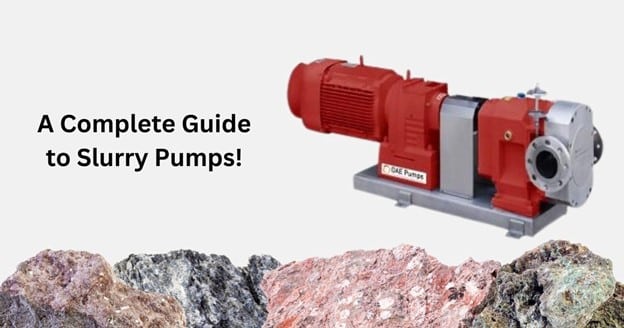Slurry Pumps is a kind of pump intended to handle a combination of liquid and solid particles called a slurry pump. Because the slurries these pumps handle can be extremely abrasive and difficult to move, they are constructed with more durability than standard water pumps. Handling slurries improperly can swiftly result in equipment failures and operational delays.
Slurry Pump Operation
Slurry pumps, particularly centrifugal pumps, play a vital role in transporting slurry materials across various industries. They work by transferring mechanical energy from a motor to the slurry through an impeller. As the impeller rotates, centrifugal force pushes the slurry outward from the center of the pump, allowing it to flow through pipes or systems.
The design of these pumps is crucial, as the internal components must withstand significant wear caused by abrasive particles within the slurry. This durability is essential for maintaining pump efficiency and longevity. Additionally, the design may vary based on the specific characteristics of the slurry being pumped, such as its viscosity, particle size, and chemical composition. Understanding these factors is key to selecting the right slurry pump for your application, ensuring optimal performance and reliability.
Slurry Pump Types
a. Centrifugal pumps for slurry
The most popular kind of slurry pump uses centrifugal force, which is produced by an impeller that rotates. Slurries in the mining, mineral processing, and dredging sectors can be transferred with great efficiency using them. These sturdy pumps can transport substantial amounts of slurry over long distances.
b. Slurry pumps with positive displacement
When centrifugal pumps are unable to handle thick, viscous slurries, positive displacement pumps are utilised. A predetermined volume of slurry is trapped by these pumps, which then push it out the discharge line. Positive displacement pumps are perfect for uses where volume is not as critical as pressure.
Slurry Pump Applications in Industries
Slurry pumps are essential in many different sectors, such as:
Slurry pumps are used in mining and mineral processing to transfer ores, coal, and other slurries rich in minerals for waste removal and processing.
- Dredging: These pumps are used to move sand, mud, and other materials from riverbeds or the seabed.
- Wastewater Treatment: By pushing combinations of solid waste and water through processing facilities, slurry pumps aid in the treatment of wastewater.
- Drilling fluids, concrete mixtures, and other slurries used in construction are handled by slurry pumps.
Important Slurry Pump Components:
Typically, a slurry pump consists of:
- The impeller is the revolving part that moves the slurry.
- Encloses the slurry and safeguards the inside parts.
- Shaft and Bearings: Hold the impeller in place and turn it.
- Liners guard against abrasive slurries causing wear and tear on the casing.
- Seal makes sure there isn’t any slurry leakage when pumping.
- Since slurries can cause significant wear over time due to their corrosive and abrasive character, every component has been engineered with durability in mind.
Maintenance of Slurry Pumps
Slurry pumps require maintenance in order to last longer and function smoothly. Frequent maintenance and inspections can reduce the need for expensive repairs and downtime.
a. Customary Exams
The impeller, seals, bearings, and casings should all be inspected for wear and tear as part of routine maintenance. It’s critical to inspect the pump system for obstructions, especially when working with slurries containing bigger particles.
b. Typical Problems and Solutions
Among the most typical problems with slurry pumps are:
Excessive wear: Pump parts frequently deteriorate more quickly than anticipated as a result of abrasive slurries. By choosing the right materials and pump type for the job, this can be lessened.
Blockages: The pump may become clogged by large or irregularly shaped particles in the slurry. This can be avoided with routine inspections and cleaning.
Seal failure: Pump seals need to be replaced on a regular basis due to their wear and tear. During operation, leaks or increased noise are frequently indicators of a seal problem.
Frequent good maintenance is essential to ensuring the slurry pump lasts a long time and functions well. This helps prevent wear and tear on the pump’s components by using the proper lubricants made especially for slurry pumps in addition to routine inspections. Furthermore, it’s crucial to keep every component well-maintained and in top operating order to minimise downtime, minimise expensive repairs, and stop unplanned breakdowns.
Advantages of Slurry Pump Use
Slurry pumps are essential in heavy-duty sectors because of their many benefits.
Durability: Slurry pumps have a longer lifespan than conventional pumps since they are made to handle abrasive materials.
Versatility: They are appropriate for numerous industrial applications because of their ability to manage a wide range of solid-liquid combinations.
High efficiency: Slurry pumps can move large amounts of material, which shortens processing times and boosts productivity.
Cost-effective: Although they may have high initial prices, their performance and longevity minimise maintenance and downtime, which lowers long-term operating expenses.
Final Thoughts
Slurry pumps provide a dependable and effective means of moving mixes of liquids and solids, making them an essential component of many industrial operations. You can maximize their effectiveness and prolong their lifespan with the necessary knowledge of how they work, the appropriate kind of pump for your needs, and routine maintenance.
Slurry pumps demonstrate their value in the mining, wastewater treatment, and construction industries by effortlessly handling some of the most difficult materials.



